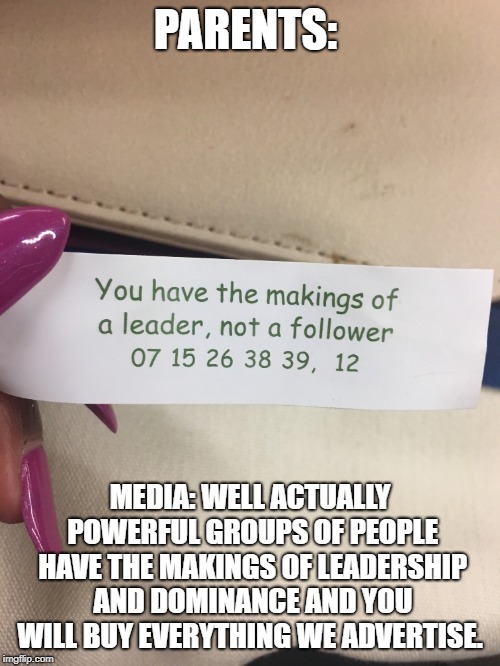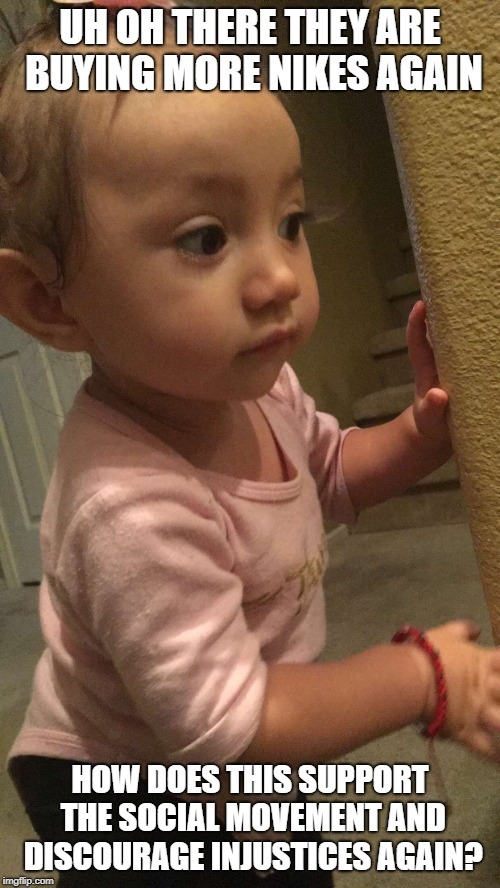Text
Businesses, Social Media Influencers, and The Self Image
Deeva Hall
Professor James Anderson
Media and Cultural Studies
7 June 2019



Businesses, Social Media Influencer, and The Self Image
For some, creating content on free social networking sites like Instagram is now done with the hopes in becoming Internet superstars and product ambassadors who receive six-figure incomes. A dark reality surrounding social media influencers and common social media users user-generated content is revealed by taking a closer look at why businesses are deciding to use social media in the first place as their primary marketing strategies as opposed to traditional marketing strategies. By analyzing key concepts in the works by Christian Fuchs, Vincent Mosco, and Asa Berger alongside mega-retailer Target Corporation (Target), we can see that big businesses quantify, hypercommericalize, and exploit the personal brand of social media influencers for monetary gain, authenticity, and the appearance of having less coercive marketing tactics.
Businesses are able to commodify social media influencers’ quantified selves. Mosco notes, “[the term quantified self]... is also used, however, in the critical sense of reducing the self to a quantity by turning a personal identity into nothing more than a statistical reading, at the expense of the qualitative, subjective, and otherwise unquantifiable dimensions of life” (101). The dark side to this is there is no limit to what extent people will go to achieve a like, follow, or comment. As a result, self worth is minimized to online presence that is based on quantifying self image. Another aspect of quantifying the “unquantifiable dimensions of life” is how corporations quantify the emotional labor of the individuals who use social media as an outlet to express their displacement in society. Target’s “Swim Body Positivity” Campaign is an example of how companies can use emotional labor as a measurable tool to sell products. While its true that Target’s advertisement of a nonnormative, nonwhite, and curvaceous woman is widening the spectrum of cultural acceptance and beauty, it’s not without monetary motive. Emotional labor is quantified when corporations monitor the patterns, interests, lifestyle, and networks of those who, in this case for example, used the hashtag body positivity and turned the qualitative data into a way to make a dollar amount.
Social Media Influencers are actual people living real lives whose personal brand appears to bring authentication and credibility to a business’ products. According to Baran, “selling more advertising on existing and new media and identifying additional ways to combine content and commercials are the two most common strategies that lead to hypercommercialism” (38). Whether created by social media influencers or average social media users, it’s hard not to notice the hyper-commercialization of nearly every photo posted. As seen in Target’s “Victoria Beckham For Target” Campaign promoting Victoria Beckham’s Target collection (mediakix.com), casual life events are being re-presented as a reason to reinforce capitalism. For Laura Izumikawa (@lauraiz), spending her birthday with her daughter meant “celebrating in style” (mediakix.com) in Beckham’s clothing line and Rachel Bilson’s (@rachelbilson) very normal day meant taking a selfie in a shirt from Beckham’s collection. From life changing celebrations to the typical day-to-day events, content and commercials are existing as one. Online post that show real people living real, normal lives while expressing how a product has enhanced life’s any given moment becomes a motivating factor that leads an influencer’s follower to behave actively in consumer culture.
Commodifying self image online is exploitative, as corporations exploit social media influencers who in turn exploit audiences. Behind every paid Instagram post is a carefully framed personal branding. Paid posts require preparation including but not limited to angles, lighting, and mise-en-scene. When the lines of self-image and work are blurred true, authentic moments are lost to fiction. As Berger mentions, “people become increasingly more alienated, they become the prisoners of their alienated needs and end up, as Marx puts it, ‘The self-conscious and self-acting commodity’” (Berger 51). Consider mommy blogger Terra (@loveandlarock) who was one of the social media influencers paid to advertise Target’s “Persil At Target” campaign (mediakix.com) on Instagram as an example. How many shots did the mommy blogger have to take to achieve the perfect photo? How many times did Terra have to step away from the moment with her daughter to check the photos? Interruption is the exploitation of social media influencers, where they become prisoners of the content they’re creating and thus becoming increasingly more “separated or estranged from their work, from friends, from themselves, and from life” (51). At the time Terra (@loveandlarock) released the “Persil At Target” advertisement on Instagram, the paid partnerships link to every paid post had already been mandated. Still, the campaign “targeted heavy laundry detergent users...by promoting Persil to audiences that have a higher than average laundry needs and changed consumer habits through the advice of trusted bloggers” (mediakix.com). In this case, Target exploited Tera’s (@loveandlarock) personal brand and her followers given that they had no knowledge of Tera’s (@loveandlarock) actual use of said product. This enabled Target to reach into the network of consumers by less apparent coercive means, but misleading nonetheless.
Overall, businesses that use social media influencers’ self image as a marketing strategy benefit in more than one just way. By quantifying, authenticating, and exploiting the online presence and personal brand of social media influencers, businesses are able to take up more space economically and digitally. Target Corporations’ Instagram campaigns are prime examples of how social media influencers contribute to culture, consumerism, and the misleading strategies that influence both culture and consumerism. Online advertising as opposed to traditional marketing proves to be more effective, effective, and regardless of the closely related dark realities, the technological advances brings propaganda to a new, digitized platform.
Works cited
Baran, Stanley J. “Convergence and the Reshaping of Mass Communication.” In Introduction to Mass Communication: Media Literacy and Culture. New York: McGraw-Hill, 2015. Pp. 29- 45.
Berger, Arthur Asa. “Marxist Analysis.” In Media Analysis Techniques. 5th ed. Thousand Oaks, CA: Sage Publications, 2014. Pp. 50-54.
“How Target Is Marketing On Instagram With Social Influencers.” Mediakix, 19 Apr. 2017, mediakix.com/2017/04/target-marketing-on-instagram-case-study/#gs.hihkn8.
Mosco, Vincent. “The Body and Culture.” In Becoming Digital: Toward a Post-Internet Society. Bingley, UK: Emerald House Publishing, 2017. Pp. 97-128.
0 notes
Text
Nike’s Kaepernick Campaign: Hegemony, Alienation, & Flak

Nike’s Colin Kaepernick campaign and President Donald Trump’s fixed attention on the Kaepernick campaign are examples of how those in power use the media to reinforce Antonio Gramsci’s concept of hegemony in “Hegemony, Intellectuals and the State.” Whereas Nike exploits lower tiers’ alienation in a capitalist society, a concept explained by Arthur Asa Berger in “Alienation” and “The Consumer Society”, President Trump deploys flak, the fourth propagandist filtre listed by Edward S. Herman and Noam Chomsky in “Propaganda Model”, to sway public opinion concerning Nike’s Kaepernick endorsement.
Nike’s advertisement featuring partnership with professional football player Colin Kaepernick critiques America’s hegemonic practices while the campaign itself epitomizes hegemonic practices. According to Gramsci, “the attempt to exercise power will always be made to ensure that force will appear to be based on the consent of the majority, expressed by the so-called organs of public opinion—newspapers and associations— which, therefore, in certain situations, are artificially multiplied” (75). The “believe in something even if it means sacrificing everything” campaign attempts to win the consent of subordinate groups through coercion. For example, market research has shown that Nike customers are mostly marginalized youths. Thirty-Mile Zone Sports calculates that “13% of Americans identify as African American, yet 18% of Nike buyers are black. Hispanics account for 16% of the population, but represent 19% of Nike buyers. And, Asians account for 3% of the population, but 5% of Nike customers” (TMZ sports). Given that Nike’s consumer base reflected a large number of minorities pre-Kaepernick endorsement, the advertisement implies more of a power move to manipulate lower tiers into a buying mood. How ever Nike expresses pro equality for people of color throughout the media the company is still a leader in violence overseas involving child labor, poor working conditions, and underpay for people of color. Clearly Nike’s endeavor sides more with sustaining capitalist hegemony than exercising activism.
Evoking emotion to manipulate marginalized audiences to spend their hard working money is a propagandist technique to maintain the hegemonic class system and shows an exploitative relationship between high and low tiers. According to Arthur Asa Berger, “People must be driven to consume, must be made crazy to consume, for its consumption that maintains the economic system. Thus the alienation generated by a capitalist system is functional, for the anxieties and miseries generated by such a system tend to be assuaged by impulsive consumption” (52). As Nike co-opts a social movement for its own private gain, people of color are emotionally moved by the company’s political stance and are even more motivated to consumption, a symptom of their alienation. For example, post-Kaepernick advertisement Nike had made $6 billion, claims Alex Abad-Santos on Vox magazine. That’s $6 billion Nike has made off of the alienated spirit in America’s capitalist society and not a portion of the revenue went to scholarship, charity, or society’s alienated. Berger quotes Karl Marx, “Every man speculates upon creating a new need in order to force him to a new sacrifice, to place him in a new dependence, and to entice him with a new pleasure and thereby in economic ruin. Everyone tries to establish over others an alien power in order to find there the satisfaction of his own egotistical need” (52). It appears that Nike established an alien power over subordinate groups especially given that their campaign diverted people’s attention from police brutality and their core message once analyzed translates to “buy shoes” which thus maintains the consumer culture and America’s hegemonic class system.
Though there has been an equilibrium of positive and negative media attention regarding Kaepernick being the face of Nike’s 30th anniversary campaign, President Donald Trump used his power and influence to bring more attention to negative media responses by producing flak to sustain hegemonic structuralism. According to Edward S. Herman and Noam Chomsky, “The producers of flak add to one another’s strength and reinforce the command of political authority in it’s news-management activities. The government is a major producer of flak, regularly assailing, threatening, and ‘correcting’ the media, trying to contain any deviations from the established line.” (28) President Donald Trump over a multitude of social media tweets has publicly rejected Nike’s decision to make Kaepernick the new face of their brand for the reason that Trump deems Kaepernick unpatriotic and his actions (kneeling during the national anthem) disrespectful to the American flag. One of Trump’s tweets read:
“Just like the NFL, whose ratings have done WAY DOWN, Nike is getting absolutely killed with anger and boycotts. I wonder if they had any idea that it would be this way? As far as the NFL is concerned, I just find it hard to watch, and always will, until they stand for the FLAG!” (Twitter).
Many right-wing conservatives, the bulk of Trump’s voters and social media followers, in response to Trump’s censure, took to twitter to burn their Nike sneakers. Trump’s power and influence to produce flak may have to an extent persuaded public opinion as Trump used propagandist techniques by associating two unrelated concepts to push hegemonic structuralism. As Trump’s statement implies, one can’t be patriotic and stand against systemic injustices, one can’t be patriotic and continue to watch the National Football League when players kneel, and those who approve of Nike’s Kaepernick campaign aren’t after all true patriots.
Overall, both Nike and President Donald Trump are large entities prevalent in mass media that act within hegemonic structuralism to main existing class systems such as capitalism and social stratification. The aftermath of Colin Kaepernick protesting police brutality led to Nike and President Trump, being powerful influencers and leaders’, to deter the public from America’s injustices to support private interests. For example, Nike manipulated its consumers’ alienation in society to support a cause that Nike fails to support in its entirety other than through motivating people to buy their shoes. Further, Trump has also deterred the public from the social movements political message by translating Kaepernick’s protest to unpatriotic. Both used media to exploit and mislead the masses and in doing so have acted to maintain hegemony.


Works cited
Abad-Santos, Alex. “Nike's Colin Kaepernick Ad Sparked a Boycott - and Earned $6 Billion for Nike.” Vox, Vox Magazine, 24 Sept. 2018, www.vox.com/2018/9/24/17895704/nike-colin-kaepernick-boycott-6-billion.
Berger, Arthur.“Alienation” and “The Consumer Society” in Media Analysis Techniques.6th edition. San Francisco State University, USA.
Gramsci, Antonio. “Hegemony, Intellectuals and the State,” in Cultural Theory and Popular Culture: A Reader, ed. John Storey, pp. 75-80. New York: Routledge, 1994[2013].
Herman, Edward and Chomsky, Noam. “A Propaganda Model,” in Manufacturing Consent: The Political Economy of the Mass Media (New York: Pantheon Books, 1988), pp. 1-35.
Staff, TMZ. “Nike's Colin Kaepernick Deal Adds Up When You See Customer Data ... And We Did.” TMZ, TMZ.com, 10 Sept. 2018, www.tmz.com/2018/09/06/colin-kaepernick-nike-contract-urban-consumers-market-research/.
Trump, Donald (@realdonaldtrump). “Just like the NFL, whose ratings have done WAY DOWN, Nike is getting absolutely killed with anger and boycotts. I wonder if they had any idea that it would be this way? As far as the NFL is concerned, I just find it hard to watch, and always will, until they stand for the FLAG!” Sept 5, 2018. 6:39 AM. Tweet.
0 notes
Text
Nike’s Kaepernick Campaign: Hegemony, Alienation, & Flak
Nike’s Colin Kaepernick campaign and President Donald Trump’s fixed attention on the Kaepernick campaign are examples of how those in power use the media to reinforce Antonio Gramsci’s concept of hegemony in “Hegemony, Intellectuals and the State.” Whereas Nike exploits lower tiers’ alienation in a capitalist society, a concept explained by Arthur Asa Berger in “Alienation” and “The Consumer Society”, President Trump deploys flak, the fourth propagandist filtre listed by Edward S. Herman and Noam Chomsky in “Propaganda Model”, to sway public opinion concerning Nike’s Kaepernick endorsement.
Nike’s advertisement featuring partnership with professional football player Colin Kaepernick critiques America’s hegemonic practices while the campaign itself epitomizes hegemonic practices. According to Gramsci, “the attempt to exercise power will always be made to ensure that force will appear to be based on the consent of the majority, expressed by the so-called organs of public opinion—newspapers and associations— which, therefore, in certain situations, are artificially multiplied” (75). The “believe in something even if it means sacrificing everything” campaign attempts to win the consent of subordinate groups through coercion. For example, market research has shown that Nike customers are mostly marginalized youths. Thirty-Mile Zone Sports calculates that “13% of Americans identify as African American, yet 18% of Nike buyers are black. Hispanics account for 16% of the population, but represent 19% of Nike buyers. And, Asians account for 3% of the population, but 5% of Nike customers” (TMZ sports). Given that Nike’s consumer base reflected a large number of minorities pre-Kaepernick endorsement, the advertisement implies more of a power move to manipulate lower tiers into a buying mood. How ever Nike expresses pro equality for people of color throughout the media the company is still a leader in violence overseas involving child labor, poor working conditions, and underpay for people of color. Clearly Nike’s endeavor sides more with sustaining capitalist hegemony than exercising activism.
Evoking emotion to manipulate marginalized audiences to spend their hard working money is a propagandist technique to maintain the hegemonic class system and shows an exploitative relationship between high and low tiers. According to Arthur Asa Berger, “People must be driven to consume, must be made crazy to consume, for its consumption that maintains the economic system. Thus the alienation generated by a capitalist system is functional, for the anxieties and miseries generated by such a system tend to be assuaged by impulsive consumption” (52). As Nike co-opts a social movement for its own private gain, people of color are emotionally moved by the company’s political stance and are even more motivated to consumption, a symptom of their alienation. For example, post-Kaepernick advertisement Nike had made $6 billion, claims Alex Abad-Santos on Vox magazine. That’s $6 billion Nike has made off of the alienated spirit in America’s capitalist society and not a portion of the revenue went to scholarship, charity, or society’s alienated. Berger quotes Karl Marx, “Every man speculates upon creating a new need in order to force him to a new sacrifice, to place him in a new dependence, and to entice him with a new pleasure and thereby in economic ruin. Everyone tries to establish over others an alien power in order to find there the satisfaction of his own egotistical need” (52). It appears that Nike established an alien power over subordinate groups especially given that their campaign diverted people’s attention from police brutality and their core message once analyzed translates to “buy shoes” which thus maintains the consumer culture and America’s hegemonic class system.
Though there has been an equilibrium of positive and negative media attention regarding Kaepernick being the face of Nike’s 30th anniversary campaign, President Donald Trump used his power and influence to bring more attention to negative media responses by producing flak to sustain hegemonic structuralism. According to Edward S. Herman and Noam Chomsky, “The producers of flak add to one another’s strength and reinforce the command of political authority in it’s news-management activities. The government is a major producer of flak, regularly assailing, threatening, and ‘correcting’ the media, trying to contain any deviations from the established line.” (28) President Donald Trump over a multitude of social media tweets has publicly rejected Nike’s decision to make Kaepernick the new face of their brand for the reason that Trump deems Kaepernick unpatriotic and his actions (kneeling during the national anthem) disrespectful to the American flag. One of Trump’s tweets read:
“Just like the NFL, whose ratings have done WAY DOWN, Nike is getting absolutely killed with anger and boycotts. I wonder if they had any idea that it would be this way? As far as the NFL is concerned, I just find it hard to watch, and always will, until they stand for the FLAG!” (Twitter).
Many right-wing conservatives, the bulk of Trump’s voters and social media followers, in response to Trump’s censure, took to twitter to burn their Nike sneakers. Trump’s power and influence to produce flak may have to an extent persuaded public opinion as Trump used propagandist techniques by associating two unrelated concepts to push hegemonic structuralism. As Trump’s statement implies, one can’t be patriotic and stand against systemic injustices, one can’t be patriotic and continue to watch the National Football League when players kneel, and those who approve of Nike’s Kaepernick campaign aren’t after all true patriots.
Overall, both Nike and President Donald Trump are large entities prevalent in mass media that act within hegemonic structuralism to main existing class systems such as capitalism and social stratification. The aftermath of Colin Kaepernick protesting police brutality led to Nike and President Trump, being powerful influencers and leaders’, to deter the public from America’s injustices to support private interests. For example, Nike manipulated its consumers’ alienation in society to support a cause that Nike fails to support in its entirety other than through motivating people to buy their shoes. Further, Trump has also deterred the public from the social movements political message by translating Kaepernick’s protest to unpatriotic. Both used media to exploit and mislead the masses and in doing so have acted to maintain hegemony.
Works cited
Abad-Santos, Alex. “Nike's Colin Kaepernick Ad Sparked a Boycott - and Earned $6 Billion for Nike.” Vox, Vox Magazine, 24 Sept. 2018, www.vox.com/2018/9/24/17895704/nike-colin-kaepernick-boycott-6-billion.
Berger, Arthur.“Alienation” and “The Consumer Society” in Media Analysis Techniques.6th edition. San Francisco State University, USA.
Gramsci, Antonio. “Hegemony, Intellectuals and the State,” in Cultural Theory and Popular Culture: A Reader, ed. John Storey, pp. 75-80. New York: Routledge, 1994[2013].
Herman, Edward and Chomsky, Noam. “A Propaganda Model,” in Manufacturing Consent: The Political Economy of the Mass Media (New York: Pantheon Books, 1988), pp. 1-35.
Staff, TMZ. “Nike's Colin Kaepernick Deal Adds Up When You See Customer Data ... And We Did.” TMZ, TMZ.com, 10 Sept. 2018, www.tmz.com/2018/09/06/colin-kaepernick-nike-contract-urban-consumers-market-research/.
Trump, Donald (@realdonaldtrump). “Just like the NFL, whose ratings have done WAY DOWN, Nike is getting absolutely killed with anger and boycotts. I wonder if they had any idea that it would be this way? As far as the NFL is concerned, I just find it hard to watch, and always will, until they stand for the FLAG!” Sept 5, 2018. 6:39 AM. Tweet.
1 note
·
View note